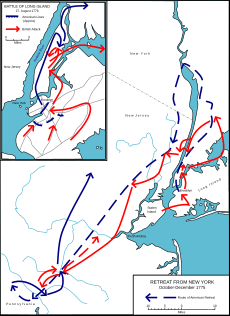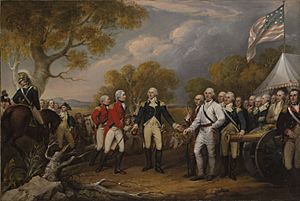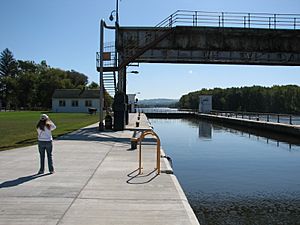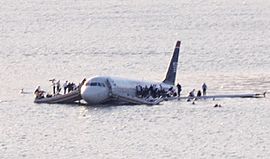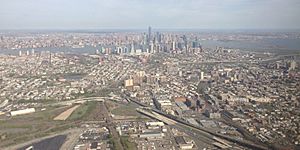History of the Hudson River facts for kids
The Hudson River is a long river, about 315 miles (507 kilometers) long, located in New York. It's named after Henry Hudson, an English explorer who sailed for the Dutch East India Company. He explored the river in 1609. Before Hudson, an Italian explorer named Giovanni da Verrazzano saw the river in 1524 while sailing for the King of France. He was the first European known to enter the Upper New York Bay, but he thought the river was just an inlet from the sea. The Dutch later called it the North River, and it was very important to their colony, New Netherland. The river was a key route into the American interior, leading to many years of competition between the English and the Dutch to control it.
In the 1700s, the Hudson River valley inspired Washington Irving, a famous American writer. Later, in the 1800s, the area influenced the Hudson River School of landscape painting, which was an American art style focused on nature. The Hudson River also became the eastern end of the Erie Canal. When the canal was finished in 1825, it became a super important way to transport goods in the early United States.
Contents
River Names Through History
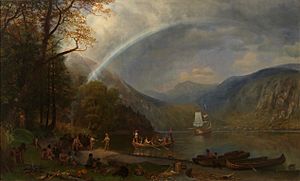
The Iroquois people called the river Ca-ho-ha-ta-te-a, which simply means "the river." The Mohican tribe, who lived along the lower parts of the river, called it Muh-he-kun-ne-tuk, meaning "river that flows two ways." This name makes sense because the river's water can flow both north and south due to the tides. The Lenape people, who are related to the Mohicans, also called it Muhheakantuck for the same reason.
The first European name for the river was Rio San Antonio, given by the Portuguese explorer Estêvão Gomes in 1525. The Dutch also called it Rio de Montaigne and later Noortrivier or "North River." They called the Delaware River the "South River." Other names used by the Dutch included "Manhattan River" and "Great River." The name "North River" was used in the New York metropolitan area until the early 1900s and is still used today in some shipping communications. The name "Hudson River" first appeared on a map in 1740.
In 1939, Life magazine called the Hudson River "America's Rhine," comparing it to the famous Rhine River in Europe.
Early Peoples of the Hudson Valley
Long before Europeans arrived, Native American tribes lived around the Hudson River. The Algonquins lived along the river, divided into three main groups: the Lenape (also known as the Delaware Indians), the Wappingers, and the Mahicans.
The Lenape Indians lived along the lower Hudson River. They were the people who met explorer Giovanni da Verrazzano, traded with Henry Hudson, and later sold the island of Manhattan. Further north, the Wappingers lived from Manhattan Island up to Poughkeepsie. They lived in villages along the river and traded with both the Lenape and the Mahicans. The Mahicans lived in the northern valley, from Kingston up to Lake Champlain, with their main village near Albany.
These three Algonquin groups spoke similar languages and could communicate with each other. They usually lived peacefully together. However, the Mahicans often had conflicts with the Mohawk Indians to the west, who were part of the Iroquois nation.
The Algonquins lived in small groups and villages. One important fortress was called Navish, located at Croton Point, overlooking the Hudson River. They lived in houses called Wigwams, which could be round or rectangular. Large families sometimes lived in longhouses that were very long. In their villages, they grew corn, beans, and squash. They also gathered nuts and berries. For food, they fished in the river for various fish like striped bass, sturgeon, and herring. Oyster beds were also common. They hunted animals like turkey, deer, and rabbits.
Exploration and Early Settlements
First European Explorers
In 1497, John Cabot sailed along the coast and claimed the land for England. In 1524, Giovanni da Verrazzano visited New York Bay. He sailed into the harbor, thinking it was the mouth of a big river, but he didn't sail up the Hudson River itself. A year later, Estêvão Gomes, a Portuguese explorer working for Spain, also visited New York Bay while looking for a shortcut to Asia.
In 1609, the Dutch East India Company hired English navigator Henry Hudson to find the Northwest Passage, a sea route through North America. Hudson sailed his ship up the river that now bears his name. As he went further north, the river widened, making him think he had found the passage. He claimed the land for the Dutch and sailed as far north as present-day Troy before realizing it wasn't the Northwest Passage.
Dutch Colony of New Netherland
After Henry Hudson's trip, the Dutch saw that the Hudson River region was good for trading furs. Explorer Adriaen Block explored the lower Hudson River and the East River, confirming that the fur trade would be profitable. So, the Dutch started a colony called New Netherland.
The Dutch set up three main trading posts: New Amsterdam, Wiltwyck, and Fort Orange. New Amsterdam was at the mouth of the Hudson River and later became New York City. Wiltwyck was about halfway up the river and became Kingston. Fort Orange was the furthest north and became Albany.
These outposts were mainly for fur trading. The Dutch tried to make friends with the Mahicans for trade, which angered the Mohawk tribe and caused fights between the Native American groups. The Native Americans traded furs for European goods, but this eventually led to fewer animals and made them rely on the Dutch for trade.
The Dutch West India Company controlled trade for about 20 years. New Amsterdam quickly became the most important city, serving as the capital and a trading center. Over time, more families moved to the colony. New businesses grew, including farming food, tobacco, timber, and even trading enslaved people.
In 1647, Peter Stuyvesant became the leader of the colony. He found it in trouble due to conflicts with the English and Native Americans. Stuyvesant improved the colony and expanded settlements along the Hudson River. However, the British soon invaded New Netherland through New Amsterdam. Since the city wasn't well defended, Stuyvesant had to surrender. New Amsterdam and the colony were renamed New York, after the Duke of York. The Dutch briefly got New York back but lost it again, ending their control over the Hudson River.
British Rule and the Road to Revolution
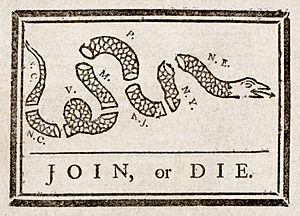
Under British rule, the Hudson Valley became a farming area. Large estates called manors were built on the east side of the river. Landlords rented land to farmers, who gave a share of their crops to the landlord. West of the river, there were smaller farms. Grain was a major crop, shipped downriver to New York City, the main port, to be sent to Great Britain.
In 1754, the Albany Congress took place in Albany, near the Hudson River. This meeting included officials from the colonies and the Iroquois nation. They discussed growing tensions between the British and the French, which led to the French and Indian Wars. The meeting also led to the Albany Plan of Union, the first attempt to create a unified government for the colonies. Although the plan wasn't approved, it set the stage for later efforts to unite the colonies during the American Revolution.
The Revolutionary War on the Hudson
The Hudson River was very important during the Revolutionary War. It connected to the Mohawk River, which could lead to the Great Lakes and the Mississippi River. Also, its closeness to Lake George and Lake Champlain meant that if the British controlled the Hudson, they could control the water route from Montreal to New York City. This would cut off New England, a strong area for the American patriots, from the rest of the colonies.
Many battles were fought along the river. On August 27, 1776, the Battle of Long Island happened in Brooklyn, at the mouth of the Hudson River. The British, with a much larger army, badly defeated George Washington's army. Washington and his troops had to escape across the East River to Manhattan under the cover of night and fog. The British then took control of New York City and used it as their headquarters for the rest of the war.
On September 15, 1776, the Battle of Harlem Heights was fought in Upper Manhattan. After retreating, Washington's army fought back against the British. Although not a complete victory, it was the first time the Continental Army won a battle, which greatly boosted their spirits. Washington later retreated further north to White Plains, New York.
In October 1776, the British attacked Washington's army at White Plains. Washington was forced to retreat across the Hudson River into New Jersey and Pennsylvania. This retreat, though difficult, allowed Washington to save his army, which later led to important victories at Trenton, New Jersey and Princeton, New Jersey.
To prevent the British from sailing up the Hudson, the Americans built forts in the Hudson Highlands, a narrow part of the river. In 1777, the British attacked and captured Fort Clinton and Fort Montgomery. However, the British soon returned to New York City.
Later, the Americans built the Great West Point Chain across the river at West Point to block British ships. This huge chain was meant to stop any fleet from passing.
In 1777, a major turning point of the war happened north of Albany at the Battles of Saratoga. British General Burgoyne planned to take Albany and control the Hudson River. He marched his army south from Canada. Another British army was supposed to join him, but it was stopped by American forces. Burgoyne's army faced many problems, including long supply lines and a lack of supplies after a defeat in Vermont.
General Burgoyne expected help from British forces sailing up the Hudson from the south, but those forces were busy elsewhere. As a result, Burgoyne's army was surrounded by the Americans. On October 17, Burgoyne surrendered his entire army. This victory convinced the French that the Americans could win, and they joined the war on the American side, providing crucial support.
Later in the war, in 1780, American General Benedict Arnold, who was secretly working for the British, planned to hand over the important fort at West Point to the British. His plan was discovered when a British major carrying Arnold's plans was captured near Tarrytown. Arnold escaped, but his betrayal was exposed.
The Industrial Revolution and Beyond
Canals and Transportation
In the early 1800s, it was hard to travel and transport goods away from the East Coast. Boats were the fastest way to move things. So, many canals were built to connect different waterways.
The most important canal was the Erie Canal. For about 100 years, people wanted a canal to connect the Great Lakes to the Hudson River. This would link the growing western parts of the United States to the busy Port of New York. Construction started in 1817 and finished in 1825. The canal was a huge success, making a lot of money. After it was built, goods could travel from cities like Pittsburgh and Chicago, through the Great Lakes, then the Erie Canal to the Hudson River, and finally south to New York City. The Erie Canal helped the American West grow and made New York City one of the most important ports in the country.
Other canals also connected to the Hudson River. The Champlain Canal connected the Hudson near Troy to Lake Champlain, allowing travel from Canada. The Oswego Canal connected the Erie Canal to Lake Ontario, bypassing Niagara Falls. The Cayuga-Seneca Canal linked the Erie Canal to Cayuga Lake and Seneca Lake. Further south, the Delaware and Hudson Canal connected the Delaware River to the Hudson at Kingston, New York, mainly for transporting coal. All these canals made the Hudson River a vital waterway for trade.
The Hudson River School of Art
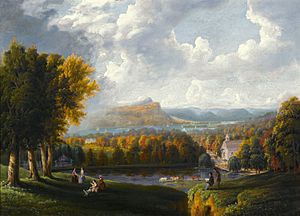
The Hudson River School was a group of artists in the 1800s whose paintings showed three main ideas about America: discovery, exploration, and settlement. Their paintings often showed the American landscape as a peaceful place where people and nature lived together. These artworks were very detailed and realistic, sometimes showing both calm farms and wild, rugged nature.
Hudson River School artists believed that America's beautiful nature was a sign of God. They were inspired by European artists and shared their love for nature with American writers like Henry David Thoreau. The school's name comes from its location in New York, its focus on landscapes, and often the Hudson River itself. Artists would travel to wild places, make sketches, and then return to their studios to paint the finished works.
Thomas Cole is seen as the founder of the Hudson River School. In 1825, he took a steamboat up the Hudson River, stopping at West Point and Catskill. He hiked into the Catskill Mountains to paint the first landscapes of the area. His friend, Asher Brown Durand, also became a famous artist in the school. Frederic Edwin Church and Albert Bierstadt were among the most successful painters of this style.
Modern Times on the Hudson
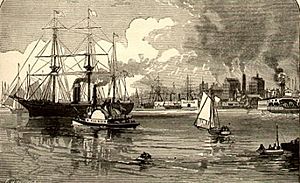
In the 1800s, railroads also became important along the Hudson. The first railroad in New York, the Mohawk and Hudson Railroad, opened in 1831, connecting Albany and Schenectady. The Hudson River Railroad was built in 1851, running along the east side of the river from New York City to Albany. In 1889, the Poughkeepsie Bridge opened, becoming the longest single-span bridge in the world at the time.
During the Industrial Revolution, many factories were built along the Hudson River, especially around Albany and Troy. The river made it easy to transport goods. Factories in towns like Poughkeepsie and Kingston used the river. The river's connection to the Erie Canal also allowed goods from the Midwest, like cars from Detroit, to be transported. In 1807, the North River Steamboat (later called Clermont) became the first successful steamboat, carrying passengers between New York City and Albany.
On September 14, 1901, Theodore Roosevelt, who was then the US Vice President, was in the Adirondacks when he learned that President William McKinley had died. Roosevelt took a long, midnight stagecoach ride to a train station at North Creek, then traveled by train to Buffalo, New York, where he was sworn in as president.
In 1910, pilot Glenn Curtiss set an American flight distance record. He flew his plane for five hours from Albany to Governor's Island near Manhattan, mostly flying over the Hudson River. This flight showed that airplanes could be used for travel between major cities.
From 1946 to 1971, the Hudson River Reserve Fleet, a group of old US Navy ships, was stored on the Hudson River.
The Hudson River Today
In 2004, Christopher Swain became the first person to swim the entire 315-mile length of the Hudson River. It took him 36 days. He did this to raise awareness about the need to make the river clean enough for swimming and drinking.
On January 15, 2009, US Airways Flight 1549 had to make an emergency landing on the Hudson River near Manhattan. The plane, with 150 passengers and 5 crew, lost power after hitting a flock of Canada geese. The pilot, Captain Chesley Sullenberger, safely landed the plane on the water. All 155 people on board were rescued quickly by nearby ferries. This event was called "the most successful ditching in aviation history."
On October 3, 2009, the old Poughkeepsie-Highland Railroad Bridge reopened as the Walkway over the Hudson. It's now a pedestrian walkway over the river, connecting to over 25 miles of walking trails.
Recently, humpback whales have been seen swimming in the Hudson River, sometimes as far north as the George Washington Bridge. This is happening because the river is getting cleaner, and there's more food for the whales. Officials warn boaters to slow down and stay at least 100 feet away from whales to avoid disturbing them.


